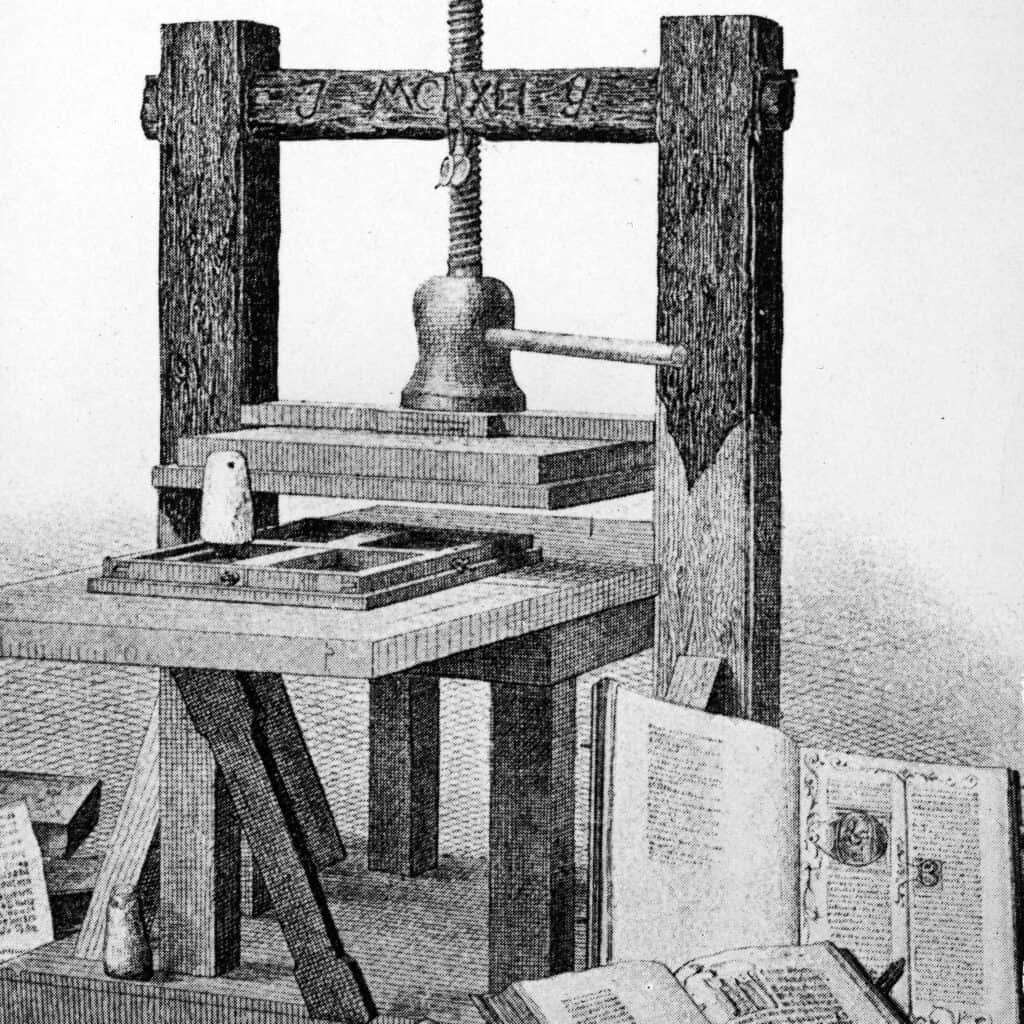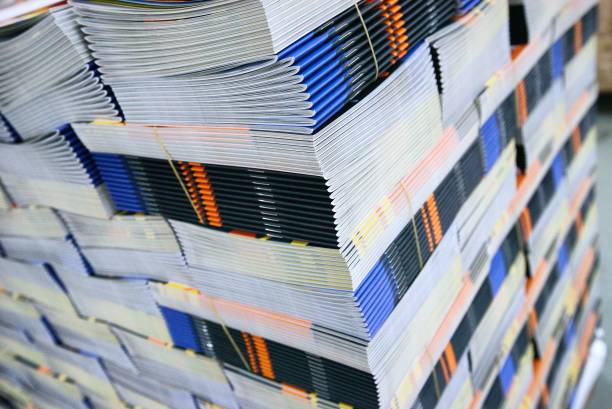
Printing’s history stretches back to around 3000 BC, with the use of clay tablets and papyrus scrolls. The codex and parchment books followed, leading to Johannes Gutenberg’s printing press in the 15th century. This invention greatly enhanced book production efficiency and accessibility, laying the groundwork for today’s mass-produced books – with the most common ad popular form being Saddle Stitch Book Printing
Technological advancements have significantly shaped book printing’s history. Innovations like offset printing, screen printing, inkjet printing, and laser printing have made the industry more efficient and affordable. Today, there is an extensive range of printing options available, including saddle stitch booklet printing, which has become increasingly popular, offering a cost-effective and versatile option for various printing needs.
Tracing the Origins of Booklet Printing
The history of booklet printing stretches back to ancient times. In those days, people used clay tablets and papyrus scrolls as early forms of books. These early writing tools set the stage for the modern booklet printing we enjoy today.
Clay Tablets and Papyrus Scrolls: The Early Precursors
In Mesopotamia and ancient Egypt, scribes started writing on clay tablets, marking the beginning of “books”. These tablets were soon replaced by papyrus scrolls, which were lighter and more flexible. Despite their limitations, these formats were crucial for the development of the codex and parchment books.
The Rise of the Codex and Parchment Books
The codex, a collection of pages bound at the back, was a major leap forward in bookmaking. It made reading and note-taking easier than scrolls. Parchment, made from animal skins, was also more durable than papyrus, making these books last longer.
These developments in book production and materials were key to the evolution of booklet printing. They have shaped how we share and preserve information for centuries. Selecting the right paper stock is crucial for ensuring the durability and quality of modern booklet printing.
Johannes Gutenberg’s Revolutionary Printing Press

The 15th century saw a groundbreaking moment with Johannes Gutenberg’s printing press invention. His use of movable type transformed book production, making it more accessible and affordable. The press enabled mass book production, significantly impacting knowledge and idea dissemination during the Renaissance.
Before Gutenberg, book production was a slow, labor-intensive process. Scribes hand-copied each page, a task that took much time. In contrast, the Gutenberg press could produce up to 3,600 pages daily, a vast improvement. This innovation set the stage for future advancements in printing, including offset printing and lithography.
The first major project of the Gutenberg press was 200 illustrated Latin bibles in 1455. This monumental task took about 3 years to finish, with all copies pre-sold. By 1500, over half a million books were in circulation, showing the press’s power in spreading knowledge.
Francis Bacon ranked the printing press among the top three inventions, alongside gunpowder and the compass. It dramatically changed society, making scribes redundant and creating new printing jobs. Benjamin Franklin, for instance, started as a printer’s apprentice, highlighting the industry’s growth.
The printing industry has seen tremendous growth since Gutenberg’s time. Today, we have faster and larger-scale production, and even home printing. Advances in technology, from offset to digital printing, have transformed how we create and use printed materials. This includes everything from booklets and pages to wire staples and binding options.
What is Saddle Stitch Booklet Printing?

Saddle stitch booklet printing is a widely-used binding method that involves folding printed sheets and stapling them together along the spine with wire staples. This technique creates a strong and durable binding, making it ideal for booklets, magazines, and catalogues with a small to medium page count, typically ranging from 8 to 80 pages. The process is straightforward: printed pages are collated, folded, and then stapled through the fold line, resulting in a neatly bound booklet. This method is not only cost-effective but also efficient, allowing for the quick production of high-quality booklets. Whether for businesses, organizations, or individuals, doing saddle stitched booklets are a product offer that provide a practical solution for creating professional-looking materials.
Saddle Stitch Book Printing: The Affordable Binding Solution
Saddle stitch book printing has become a cost-effective and versatile option for shorter printed materials, including print booklets. This includes booklets, magazines, and catalogues. It involves stapling the pages along the centre fold, making content easily accessible.
A ‘self cover’ option, where the cover and inner pages are printed on the same paper stock, is also available. This choice is budget-friendly and ideal for catalogues, magazines, and other multipurpose materials.
Understanding Saddle Stitching: A Cost-Effective Binding Method
Saddle stitching can bind between 8 and 64 pages, depending on the paper’s thickness. The inner pages play a crucial role in the overall quality and appearance of the booklet, especially considering production techniques like creep and bleed. For 105 gsm art paper, the maximum is 64 pages. For 128 gsm art paper, it’s up to 48 pages. This method is known for its quick turnaround, sometimes just three days. It’s a practical choice for authors and publishers.
Selecting the right paper type, such as 100GSM laser paper, 140GSM uncoated paper, or 150GSM satin paper, is essential to enhance the appearance and functionality of the booklet.
Benefits of Saddle Stitch Booklet Printing
Saddle stitch booklet printing comes with a host of benefits that make it a popular choice for various printing needs:
- Cost-effectiveness: One of the primary advantages of saddle stitch booklet printing is its affordability. This method is budget-friendly, making it perfect for small to medium-sized print runs without compromising on quality.
- Efficiency: The saddle stitch binding process is quick and straightforward, allowing for fast turnaround times. This efficiency is particularly beneficial for projects with tight deadlines.
- Durability: Despite its simplicity, saddle stitch binding is strong and durable. The wire staples securely hold the pages together, ensuring the booklet can withstand handling and distribution.
- Flexibility: Saddle stitch booklets can be customized in various sizes, paper types, and orientations. This flexibility allows for the creation of unique and tailored products that meet specific needs and preferences.
The Evolution of Saddle Stitch Booklet Printing in Modern Times
Saddle stitch booklet printing has gained popularity for various printed materials. This includes magazines, catalogues, booklets, and self-published works. It offers a flexible and efficient way to produce high-quality materials without the expense of expensive binding solutions. Saddle stitched books have a flat opening, ideal for seamless designs across two pages. They are also lighter and less costly to ship.
A well-designed front cover and back cover are crucial for the overall presentation of the booklet. Ensuring that the design files are clearly labeled and match the specified dimensions is essential for a professional finish.
This binding method is both cost-effective and environmentally friendly. It enhances the attractiveness and user-friendliness of the final product. With options for paper types, finishes, and sizes, it’s versatile for different printed materials. Whether printing pages, magazines, or hard cover options, saddle stitch binding is an affordable and practical printing solution. It can significantly improve the quality and presentation of your covers.
Uses for Saddle Stitch Book Printing

Saddle stitch booklets are incredibly versatile and can be utilized for a wide range of applications. Here are some common uses:
- Marketing Materials: Saddle stitch booklets are ideal for creating marketing materials such as brochures, catalogues, and sales sheets. Their professional appearance and durability make them perfect for showcasing products and services.
- Event Programs: Whether for conferences, festivals, or weddings, saddle stitch booklets are perfect for event programs. They provide a convenient and attractive way to present schedules, speaker information, and other essential details.
- Educational Materials: From textbooks and workbooks to study guides, saddle stitch booklets are excellent for educational purposes. Their durability ensures they can withstand frequent use by students and educators.
- Promotional Materials: Saddle stitch booklets can also be used for promotional materials like menus, flyers, and newsletters. Their customizable nature allows businesses to create eye-catching and informative pieces that effectively communicate their message.
By understanding the benefits and uses of saddle stitch booklets, it becomes clear why this binding method remains a popular choice for various printing needs. Whether for marketing, events, education, or promotion, saddle stitch booklet printing offers a reliable and cost-effective solution.
Digital Printing: A Paradigm Shift in Book Production
Digital printing has transformed the book production industry, ushering in a new era. It allows for on-demand book creation, eliminating the need for large print runs and reducing waste. This shift empowers self-publishing authors, giving them more control and flexibility over their work.
Uncoated paper is particularly beneficial in digital printing, offering a matte finish and aesthetic appeal that enhances the quality of booklets and other printed materials.
Digital printing also enhances customisation, enabling the creation of unique, personalised books. This transition has made the book production process more efficient, cost-effective, and environmentally friendly.
The Self-Publishing Renaissance: Empowering Authors
This shift has allowed authors to bypass traditional publishing and maintain creative control. Local printers in Melbourne, Australia, are crucial in supporting this movement. They provide high-quality book printing and binding services tailored to independent authors’ needs.
Authors can now create and upload their PDF and image files easily. They can process their manuscripts through a user-friendly form and fill out the necessary details. Local printers offer various binding options, from saddle stitch to perfect binding. This ensures authors can produce a suitable and professional-looking book for their customers.
The self-publishing revolution has empowered authors to manage their website, contact information, and pricing and delivery of their books. This allows them to connect directly with their audience and maintain a strong digital presence. This newfound freedom has created a thriving ecosystem of self-published authors, supported by local printers in Melbourne and beyond.
Conclusion
The journey through the history of saddle stitch booklet printing reveals a rich evolution. It spans from ancient print methods like clay tablets and papyrus scrolls to the groundbreaking impact of Johannes Gutenberg’s printing press. The industry has continually adapted, transforming to meet the evolving needs of authors, publishers, and readers.
The advent of digital printing has empowered self-publishing authors. It offers cost-effective and customisable options for producing high-quality booklets. The flexibility and accessibility of Saddle Stitch Book Printing have made it a cornerstone of the modern printing world. It caters to a broad spectrum of print needs, from slim magazines to compact booklets with fewer than 64 pages.
The appeal of saddle stitch booklet printing persists due to its cost-effectiveness, ease of use, and environmental benefits. It offers a range of customisation options and accommodates various paper types and cover designs. This binding method remains a dependable and versatile choice for authors, publishers, and businesses aiming to present their content professionally and engagingly.








